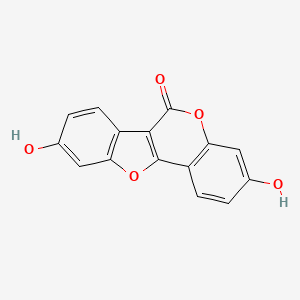| MeSH term | MeSH ID | Detail |
|---|---|---|
| Breast Neoplasms | D001943 | 24 associated lipids |
| Lupus Erythematosus, Systemic | D008180 | 43 associated lipids |
| Pancreatic Neoplasms | D010190 | 77 associated lipids |
| Colonic Neoplasms | D003110 | 161 associated lipids |
| Mammary Neoplasms, Experimental | D008325 | 67 associated lipids |
| Body Weight | D001835 | 333 associated lipids |
| Edema | D004487 | 152 associated lipids |
| Weight Gain | D015430 | 101 associated lipids |
| Endometriosis | D004715 | 29 associated lipids |
| Birth Weight | D001724 | 23 associated lipids |
COUMESTROL
COUMESTROL is a lipid of Polyketides (PK) class. Coumestrol is associated with abnormalities such as Infertility, Renal tubular disorder, Osteoporosis, Postmenopausal, Nodule and Central precocious puberty. The involved functions are known as Process, antagonists, Accident due to exposure to weather conditions, physiological aspects and Cell Proliferation. Coumestrol often locates in Blood, Body tissue, Reproductive system, Membrane and Myometrial. The associated genes with COUMESTROL are GAPDH gene, PPID gene, pyridinoline, NODAL gene and Nitrogen fixation gene. The related lipids are enterodiol. The related experimental models are Mouse Model.
Cross Reference
Introduction
To understand associated biological information of COUMESTROL, we collected biological information of abnormalities, associated pathways, cellular/molecular locations, biological functions, related genes/proteins, lipids and common seen animal/experimental models with organized paragraphs from literatures.
What diseases are associated with COUMESTROL?
COUMESTROL is suspected in Infertility, Renal tubular disorder, Osteoporosis, Postmenopausal, Nodule, Central precocious puberty and other diseases in descending order of the highest number of associated sentences.
Related references are mostly published in these journals:
| Disease | Cross reference | Weighted score | Related literature |
|---|
Possible diseases from mapped MeSH terms on references
We collected disease MeSH terms mapped to the references associated with COUMESTROL
PubChem Associated disorders and diseases
What pathways are associated with COUMESTROL
There are no associated biomedical information in the current reference collection.
PubChem Biomolecular Interactions and Pathways
Link to PubChem Biomolecular Interactions and PathwaysWhat cellular locations are associated with COUMESTROL?
Visualization in cellular structure
Associated locations are in red color. Not associated locations are in black.
Related references are published most in these journals:
| Location | Cross reference | Weighted score | Related literatures |
|---|
What functions are associated with COUMESTROL?
Related references are published most in these journals:
| Function | Cross reference | Weighted score | Related literatures |
|---|
What lipids are associated with COUMESTROL?
Related references are published most in these journals:
| Lipid concept | Cross reference | Weighted score | Related literatures |
|---|
What genes are associated with COUMESTROL?
Related references are published most in these journals:
| Gene | Cross reference | Weighted score | Related literatures |
|---|
What common seen animal models are associated with COUMESTROL?
Mouse Model
Mouse Model are used in the study 'Modulation of tumor formation and intestinal cell migration by estrogens in the Apc(Min/+) mouse model of colorectal cancer.' (Javid SH et al., 2005).
Related references are published most in these journals:
| Model | Cross reference | Weighted score | Related literatures |
|---|
NCBI Entrez Crosslinks
All references with COUMESTROL
Download all related citations| Authors | Title | Published | Journal | PubMed Link |
|---|---|---|---|---|
| Knuckles BE et al. | Quantitative determination of coumestrol in dried alfalfa and alfalfa leaf protein concentrates containing chlorophyll. | 1975 | J Assoc Off Anal Chem | pmid:1158842 |
| Sun AS et al. | Pilot study of a specific dietary supplement in tumor-bearing mice and in stage IIIB and IV non-small cell lung cancer patients. | 2001 | Nutr Cancer | pmid:11588907 |
| Rajnarayanan RV et al. | Regulation of phenobarbital-mediated induction of CYP102 (cytochrome P450(BM-3)) in Bacillus megaterium by phytochemicals from soy and green tea. | 2001 | J. Agric. Food Chem. | pmid:11600046 |
| Matthews JB et al. | Reciprocal mutagenesis between human alpha(L349, M528) and rainbow trout (M317, I496) estrogen receptor residues demonstrates their importance in ligand binding and gene expression at different temperatures. | 2001 | Mol. Cell. Endocrinol. | pmid:11604233 |
| Schobel U et al. | High resolution screening of plant natural product extracts for estrogen receptor alpha and beta binding activity using an online HPLC-MS biochemical detection system. | 2001 | J Biomol Screen | pmid:11689129 |
| Brazier M et al. | O-Glucosyltransferase activities toward phenolic natural products and xenobiotics in wheat and herbicide-resistant and herbicide-susceptible black-grass (Alopecurus myosuroides). | 2002 | Phytochemistry | pmid:11809449 |
| Morito K et al. | Interaction of phytoestrogens with estrogen receptors alpha and beta (II). | 2002 | Biol. Pharm. Bull. | pmid:11824555 |
| Whitten PL et al. | Neurobehavioral actions of coumestrol and related isoflavonoids in rodents. | 2002 Jan-Feb | Neurotoxicol Teratol | pmid:11836071 |
| Milligan S et al. | Oestrogenic activity of the hop phyto-oestrogen, 8-prenylnaringenin. | 2002 | Reproduction | pmid:11866690 |
| Diel P et al. | Effects of the environmental estrogens bisphenol A, o,p'-DDT, p-tert-octylphenol and coumestrol on apoptosis induction, cell proliferation and the expression of estrogen sensitive molecular parameters in the human breast cancer cell line MCF-7. | 2002 | J. Steroid Biochem. Mol. Biol. | pmid:11867264 |
